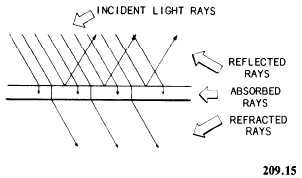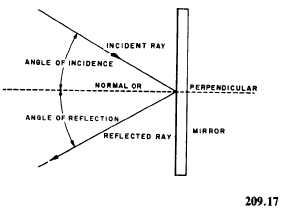|
[ Back ] [ Home ] [ Up ] [ Next ]
Click
here to Order your Radar Equipment Online
Candlepower and Footcandles
Illumination is the light received from
a light source. The intensity of
illumination is measured in
footcandles. A footcandle is the amount of light falling
upon a 1-square-foot surface which is 1 foot
away from a 1-candlepower light source.
REFLECTION
The term reflected light refers
to those light waves that are
neither transmitted nor absorbed

Figure 5-3-3.Light rays
reflected, absorbed, and refracted.
but are thrown back from the surface of the medium
they encounter. If a ray of light is directed
against a mirror, the light ray that strikes the
surface is called the incident
ray; the one that bounces
off is the reflected ray (see fig.
5-3-4). The imaginary line
perpendicular to the mirror at the
point where the ray strikes is the normal.
The angle
between the incident ray and the normal is

Figure
5-3-4.Terms used to describe the reflection of light.
the
angle of incident.
The angle between the reflected ray
and the normal is the angle
of reflection. If
the surface of the medium contacted by the incident
light ray is smooth and polished, such as a mirror,
the reflected light is thrown back at the same angle
to the surface as the incident light. The path of the
light reflected from the surface forms an angle exactly
equal to the one formed by its path in reaching the
medium. This conforms to the law of reflection which
states that the angle of incident is equal to the angle
of reflection.
Reflection from a smooth-surfaced object presents a
few problems. It is a different matter, however, when
a rough surface reflects the light. The law of reflection
still holds out because the surface is uneven, the
angle of incident is different for each ray of light. The
reflected light is scattered in all directions as shown
in figure 5-3-5 and is called irregular or diffused
light.
[ Back ] [ Home ] [ Up ] [ Next ]
| 